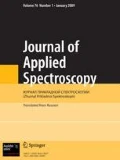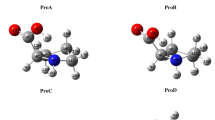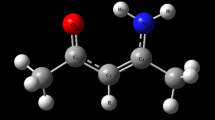Abstract
Calculation of the spectra of intermolecular complexes of 3-aminophthalimide is used as an example to show that when hydrogen bonds are present, the resonance integrals for the proton donor and acceptor atoms are different from zero. Theoretical analysis of strained 3-aminophthalimide complexes allowed us to establish the determining role of hydrogen bonds in their formation. Using an intramolecular peptide hydrogen bond as an example, we studied the effect of the solvent on its parameters. In particular, we showed that hydrogen bond formation with a proton-acceptor group of the chelate ring leads to a decrease in the resonance integral, and consequently a decrease in the enthalpy of formation of the intramolecular hydrogen bond, to a significantly greater degree than formation of a hydrogen bond at a proton-donor group.
Similar content being viewed by others
References
C. Reichardt, Solvents and Solvent Effects in Organic Chemistry [Russian translation from English; V. S. Petrosyan, ed.], Mir, Moscow (1991), pp. 37, 40, 55–56.
I. M. Gulis, Laser Spectroscopy [in Russian], Bel. Gos. Univ., Minsk (2002), pp. 102–109.
I. M. Gulis, A. I. Komyak, and K. A. Saechnikov, Zh. Prikl. Spektr., 62, No. 6, 140–145 (1995).
G. C. Pimentel and A. L. McClellan, The Hydrogen Bond [Russian translation from English; V. M. Chulanovskii, ed.], Mir, Moscow (1964).
J. N. Murrell, S. F. A. Kettle, and J. M. Tedder, Valence Theory [Russian translation from English; M. G. Veselov, ed.], Mir, Moscow (1968), pp. 348–357, 450–453.
I. I. Grandberg, Organic Chemistry [in Russian], Drofa (2002), pp. 10–12, 36–38.
A. Streitwieser, Molecular Orbital Theory [Russian translation from English; M. E. Dyatkina, ed.], Mir, Moscow (1965), pp. 42–65, 100–105, 113–126, 197–204.
M. J. S. Dewar, Molecular Orbital Theory of Organic Chemistry [Russian translation from English; M. E. Dyatkina, ed.] Mir, Moscow (1972), pp. 83–103, 125–135, 200–204.
G. A. Segal, ed., Semiempirical Methods of Electronic Structure Calculation [Russian translation from English; A. M. Brodskii, ed.], Mir, Moscow (1980), Vol. 1, pp. 13–46.
R. S. Mulliken, C. A. Rieke, D. Orloff, and H. Orloff, J. Chem. Phys., 17, 1248–1267 (1949).
K. F. Krivul’ko and A. P. Klishchenko, Zh. Prikl. Spektr., 73, 666–669 (2006).
Y. Chen and M. R. Topp, Chem. Phys., 283, 249–268 (2002).
Author information
Authors and Affiliations
Corresponding author
Additional information
__________
Translated from Zhurnal Prikladnoi Spektroskopii, Vol. 73, No. 6, pp. 735–740, November–December, 2006.
Rights and permissions
About this article
Cite this article
Krivul’ko, K.F., Klishchenko, A.P. Calculation of electronic spectra for intermolecular complexes of 3-aminophthalimide by a modified Hückel molecular orbital method. J Appl Spectrosc 73, 822–828 (2006). https://doi.org/10.1007/s10812-006-0161-6
Received:
Issue Date:
DOI: https://doi.org/10.1007/s10812-006-0161-6




